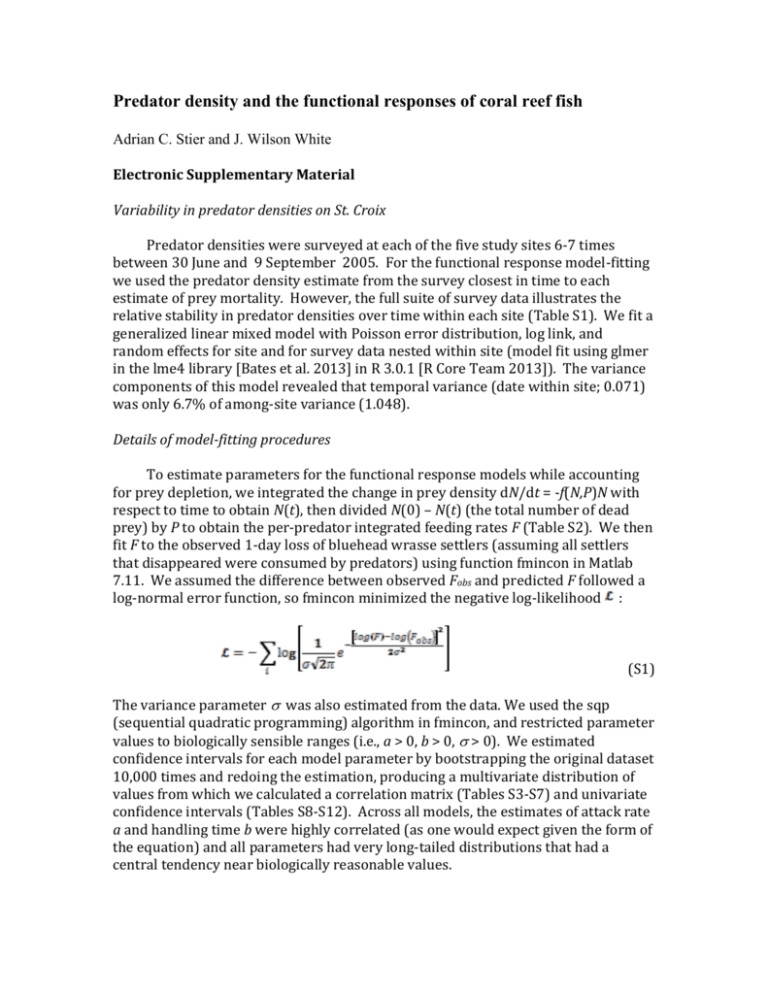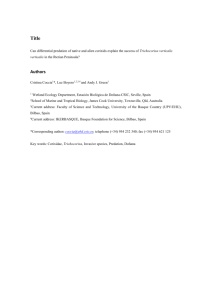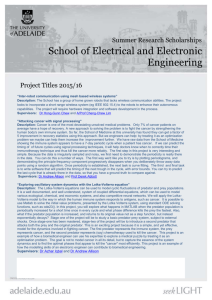Predator density and the functional responses of coral reef fish
advertisement

Predator density and the functional responses of coral reef fish Adrian C. Stier and J. Wilson White Electronic Supplementary Material Variability in predator densities on St. Croix Predator densities were surveyed at each of the five study sites 6-7 times between 30 June and 9 September 2005. For the functional response model-fitting we used the predator density estimate from the survey closest in time to each estimate of prey mortality. However, the full suite of survey data illustrates the relative stability in predator densities over time within each site (Table S1). We fit a generalized linear mixed model with Poisson error distribution, log link, and random effects for site and for survey data nested within site (model fit using glmer in the lme4 library [Bates et al. 2013] in R 3.0.1 [R Core Team 2013]). The variance components of this model revealed that temporal variance (date within site; 0.071) was only 6.7% of among-site variance (1.048). Details of model-fitting procedures To estimate parameters for the functional response models while accounting for prey depletion, we integrated the change in prey density dN/dt = -f(N,P)N with respect to time to obtain N(t), then divided N(0) – N(t) (the total number of dead prey) by P to obtain the per-predator integrated feeding rates F (Table S2). We then fit F to the observed 1-day loss of bluehead wrasse settlers (assuming all settlers that disappeared were consumed by predators) using function fmincon in Matlab 7.11. We assumed the difference between observed Fobs and predicted F followed a log-normal error function, so fmincon minimized the negative log-likelihood : (S1) The variance parameter was also estimated from the data. We used the sqp (sequential quadratic programming) algorithm in fmincon, and restricted parameter values to biologically sensible ranges (i.e., a > 0, b > 0, > 0). We estimated confidence intervals for each model parameter by bootstrapping the original dataset 10,000 times and redoing the estimation, producing a multivariate distribution of values from which we calculated a correlation matrix (Tables S3-S7) and univariate confidence intervals (Tables S8-S12). Across all models, the estimates of attack rate a and handling time b were highly correlated (as one would expect given the form of the equation) and all parameters had very long-tailed distributions that had a central tendency near biologically reasonable values. One difficulty in estimation was that Eq. S1 cannot be evaluated if Fobs is equal to zero (no observed deaths) or to (which results when predator density = 0). Rather than exclude those observations, we assumed that both mortality and predator density were observed with some error, so it was unlikely that either value was exactly zero. Therefore for those cases we set Fobs to be equal to the minimum non-zero or maximum finite values observed in the dataset. The ordering of results (i.e., which model was most parsimonious) was robust to alternative corrections we applied, such as making the minimum value 10% or 1% of the minimum observed non-zero value, so we are confident that applying this correction did not produce arbitrary conclusions. Table S1. Summary of predator survey data on St. Croix reefs in 2005. Site BB CB NS JB WC n (number of surveys) 7 7 7 6 7 Mean coney grouper density (number per 150 m2) 3.4286 2.8674 6.1198 0.5000 0.4858 Table S2. Time-integrated solution for each functional response model Model Formula H2 BD CM HV RD Note: denotes the Wright omega function Table S3. Correlation matrix for H2 model parameters a b a 1 0.9256 210-16 b 1 -210-14 1 Table S4. Correlation matrix for BD model parameters a b a 1 0.9904 0.9620 -0.0308 b 1 0.9232 -0.0144 c 1 -0.0367 1 Table S5. Correlation matrix for CM model parameters a b a 1 0.9896 0.1756 -0.0153 Standard error 0.3770 0.3527 0.3527 0.4072 0.3683 b c 1 0.1800 1 -0.0130 -0.0426 1 Table S6. Correlation matrix for HV model parameters a b m a 1 0.8059 0.6678 0.1051 b 1 0.4226 0.1519 m 1 0.2501 1 Table S7. Correlation matrix for RD model parameters a b a 1 0.9953 -0.0053 b 1 -0.0023 1 Table S8. Confidence intervals (95%) for H2 model parameters Parameter lower median upper a 0.1816 0.3391 17.1913 b 0.0242 14.7720 1.010-10 1.6871 1.6871 1.6871 Table S9. Confidence intervals (95%) for BD model parameters Parameter lower median upper a 0.1908 0.7411 434.1583 b 0.1880 197.2059 1.010-10 -10 c 0.5587 0.8424 1.010 0.5140 0.8424 1.0588 Table S10. Confidence intervals (95%) for CM model parameters Parameter lower median upper a 0.1780 1.4853 648.6314 -10 b 0.4090 261.8480 1.010 c -0.0921 0.6584 2.7845 0.5166 0.8194 1.0665 Table S11. Confidence intervals (95%) for HV model parameters Parameter lower median upper a 0.1654 1.4601 11.9923 b 0.0102 0.9092 8.7194 m 0.1417 0.8899 2.1249 0.5389 0.8258 1.2121 Table S12. Confidence intervals (95%) for RD model parameters Parameter lower median upper a 0.4508 1.1501 9.6793 b 0.1858 0.5478 10.5260 0.5318 0.8724 1.1095









